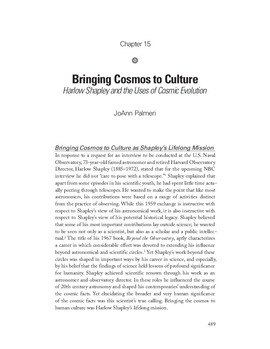| dc.contributor.author | Palmeri, JoAnn | |
| dc.contributor.editor | Dick, Stephen J. | |
| dc.contributor.editor | Lupisella, Mark | |
| dc.creator | Palmeri, JoAnn | |
| dc.date.accessioned | 2014-01-30T22:16:42Z | |
| dc.date.accessioned | 2016-03-30T15:33:03Z | |
| dc.date.available | 2014-01-30T22:16:42Z | |
| dc.date.available | 2016-03-30T15:33:03Z | |
| dc.date.issued | 2009 | |
| dc.identifier.citation | Palmeri, JoAnn (2009). Bringing Cosmos to Culture : Harlow Shapley and the Uses of Cosmic Evolution. In S. Dick and M. Lupisella (Eds.), Cosmos & Culture (pp. 489-521). Washington, DC: National Aeronautics and Space Administration, Office of External Relations, History Division. | en_US |
| dc.identifier.isbn | 9780160831195 | |
| dc.identifier.uri | https://hdl.handle.net/11244/7924 | |
| dc.description | This is a book chapter from the NASA book Cosmos and Culture: Cultural Evolution in a Cosmic Context.
The full book is available from http://www.nasa.gov/connect/ebooks/hist_culture_cosmos_detail.html | |
| dc.description.abstract | In response to a request for an interview to be conducted at the U.S. Naval Observatory, 73-year-old famed astronomer and retired Harvard Observatory Director, Harlow Shapley (1885–1972), stated that for the upcoming NBC interview he did not “care to pose with a telescope.” Shapley explained that apart from some episodes in his scientific youth, he had spent little time actually peering through telescopes. He wanted to make the point that like most astronomers, his contributions were based on a range of activities distinct from the practice of observing. While this 1959 exchange is instructive with respect to Shapley’s view of his astronomical work, it is also instructive with respect to Shapley’s view of his potential historical legacy. Shapley believed that some of his most important contributions lay outside science; he wanted to be seen not only as a scientist, but also as a scholar and a public intellectual. The title of his 1967 book, "Beyond the Observatory," aptly characterizes a career in which considerable effort was devoted to extending his influence beyond astronomical and scientific circles. Yet Shapley’s work beyond these circles was shaped in important ways by his career in science, and especially, by his belief that the findings of science held lessons of profound significance for humanity. Shapley achieved scientific renown through his work as an astronomer and observatory director. In these roles he influenced the course of 20th century astronomy and shaped his contemporaries’ understanding of the cosmic facts. Yet elucidating the broader and very human significance of the cosmic facts was this scientist’s true calling. Bringing the cosmos to human culture was Harlow Shapley’s lifelong mission. | |
| dc.format.extent | 33 pages | en_US |
| dc.format.extent | 251,703 bytes | en_US |
| dc.format.medium | application.pdf | en_US |
| dc.language | en_US | en_US |
| dc.relation.ispartof | Cosmos & culture : cultural evolution in a cosmic context. (Washington, DC : National Aeronautics and Space Administration, Office of External Relations, History Division : For sale by the Supt. of Docs., U.S. G.P.O., 2009. | en_US |
| dc.relation.ispartof | NASA SP (Series) ; 4802. | en_US |
| dc.relation.requires | Adobe Acrobat Reader | en_US |
| dc.subject.lcsh | Shapley, Harlow, 1885-1972 | en_US |
| dc.subject.lcsh | Cosmology -- Social aspects | en_US |
| dc.subject.lcsh | Science news | en_US |
| dc.subject.lcsh | Philosophy and science | en_US |
| dc.title | Bringing cosmos to culture : Harlow Shapley and the uses of cosmic evolution | en_US |
| dc.type | Book chapter | en_US |
| dc.type.material | text | en_US |
